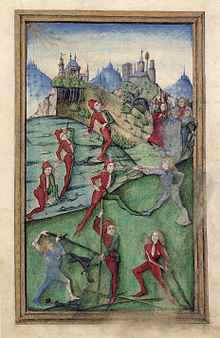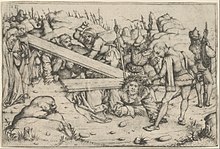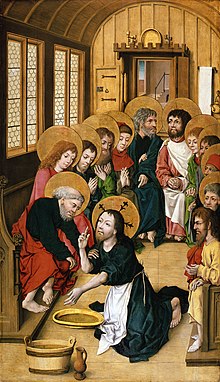Master of the house book

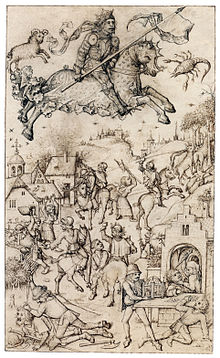
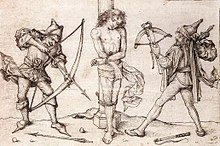
The master of the house book , often referred to for short as the house book master , also known as the master of the Amsterdam cabinet , master of the genre scenes of the house book and master of the Speyer altar , is a controversial group of German and probably also Dutch draftsmen, painters and engravers who between about 1470 and 1505 was active in the Rhine Palatinate and Middle Rhine area and is named after the house book at Wolfegg Castle .
Artist's hands in the so-called Wolfegg house book
The group of artists was named after a manuscript illustrated around 1480, which was kept in the library of the Princes of Waldegg-Wolfburg until 2008. The manuscript was reproduced and known in the 19th century under the newly formulated name "Hausbuch". Since at that time a draftsman was assumed, the emergency name "Hausbuchmeister" was initially used in the singular.
According to more recent findings from the 1990s, at least five different drawing hands are recognized in the handwriting of the house book.
- Draftsman I: Of the planetary pictures in the house book, Saturn, Jupiter and Mercury are attributed to a draftsman who can be recognized by his way of drawing. It is quite similar to the drawings of the second group, but probably belongs to an artist of its own. He works intensively with templates from contemporary printmaking. Since numerous individual motifs were incorporated into the pontifical of Mainz Archbishop Adolph von Nassau, which was completed at the latest in 1475, it is assumed that these drawings were made around 1470.
- Draftsman II: The other planetary pictures in the house book, Mars, Sol and Luna, are attributed to a second draftsman who shows a particularly high level of drawing skills and great artistic individuality. The same artist is seen here who also created the famous drypoint stitches of the Amsterdam Cabinet and who is therefore also listed under the appropriate emergency name. Since numerous individual motifs were incorporated into the pontifical of Mainz Archbishop Adolph von Nassau, which was completed at the latest in 1475, it is assumed that these drawings were made around 1470.
- Draftsman III: Another draftsman brought a juggler's scene into the house book, created the colored coat of arms with the golden branch and painted the tendril decorations in the planetary part of the house book. The same hand was also identified in another manuscript from the Middle Rhine, the pontifical of Mainz Archbishop Adolph von Nassau, created around 1470, which was created in the so-called workshop of the Mainz Giant Bible. The planetary part must have been in this book painting workshop at that time, as the painter of the juggler's scene again very faithfully adopted various motifs from the planetary representations in the house book (hands I and II) into the pontifical.
- Draftsman IV: A large number of scenes from the aristocratic life of the time were created by the so-called "master of genre scenes", which give a detailed insight into aristocratic lifestyles (tournaments, garden festivals, military campaigns) and technical equipment (guns, pumps). Since the imperial camp in front of Neuss is shown here in 1475 on one sheet, these illustrations will have been made shortly after this point in time.
- Draftsman V: Finally, another draftsman depicted a mine.
It could be proven that the majority of the illustrations in the house book were created in very close connection with the so-called workshop of the Mainz Giant Bible , which worked in Mainz between around 1470 and 1500 and was in close connection with the printing house of Peter Schöffer . Common templates were used, images found in the house book appear in other manuscripts in this workshop, and most of the draftsmen in the house book can also be identified as draftsmen in other books in this workshop.
plant

According to the current state of research, the so-called master of the house book is probably several artists, but the draftsman of the planetary pictures Mars, Sol and Luna (artist hand II) is regarded as the really important artist personality and is asked about his further work. This master of the three particularly high-quality depictions of planets is also better known in art history as the master of the Amsterdam Cabinet , as he created a large number of important drypoint works in the Amsterdam Rijksmuseum that are well known in art history . In contrast to many other ascriptions, science has never questioned the connection between the three images of the planets and the drypoint work.
This caretaker in the narrower sense (draftsman of the three pictures of the planets and the dry needle pricks) worked with great certainty mainly on the northern Upper Rhine and southern Middle Rhine in the area of the princely courts in Mainz or Heidelberg .
In addition to drawings and the famous drypoint etchings, he probably also created portraits as paintings. His best-known work in this genre is probably the so-called Gotha lovers (around 1480), the first independent double portrait in German panel painting.
Up to now there has been no agreement in academia about the artist's origin, training and specific way of working. However, numerous borrowings can be observed with him in miniature painting from the 1450s and 1460s from Utrecht . References to illuminators such as the master of Katharina von Kleve or Lieven van Lathem are mentioned without being able to prove a direct student body. The master of the Amsterdam Cabinet thus stands in a tradition that tied in with the greatest artistic innovations by Jan van Eyck and Rogier van der Weyden and made them usable for small formats and other pictorial tasks.
The complex of works of the so-called house book master became a style-defining feature of art on the Middle and Upper Rhine in the last third of the 15th century and must be seen by artists (e.g. Albrecht Dürer ) and clients, especially from the courtly environment (e.g. Johann XX. von Dalberg ) met with great interest.
According to more recent research by Daniel Hess, many of the works attributed to the master in earlier art history are probably not personally attributable to him or not completely executed by him, even if close contacts are clearly recognizable. Here u. a. the emergency name Meister des Speyerer Altar used, without that a foreign authorship would definitely be proven. Perhaps many of the stylistically similar works were created in his workshop. There is actually no doubt that there must have been such a framework for the many stylistic and motivic works that were dependent on the caretaker. There is no agreement in art history as to whether it was kept by the master of the house book, alias Master of the Amsterdam Cabinet. Their location is also not known; Heidelberg, Mainz and Speyer are particularly considered.
Attempts to identify the caretaker
Repeated attempts have been made to determine the concrete historical identity of the leading artist (master of the Amsterdam Cabinet) or other artists in the house book. The amplified by several art historians since 1936 stated hypothesis that the Master of the house book (in the narrow sense) with the documentary and with important works in the 1480s in Mainz proven Erhard Reuwich of Utrecht is to be identified, has not been able fully to enforce today . As a rule, the divergent style and the mastery of perspective, which the caretaker does not observe, in the cityscapes of Reuwich's main work of the illustrated travelogue to the Holy Land "Peregrinatio in terram sanctam" (1486) is cited as the main reason for different authorship.
However, this argument was refuted by Frederike Timm in 2006 when she was able to show that various city portraits of Reuwich actually go back to models from the Venetian workshop of the Bellinis, especially Giovanni Bellini . In particular, they can only be used to a limited extent for questions of attribution or depreciation.
Traditionally assigned works, some of which come from different artist hands
Painting:
- Basel, art museum
- Portrait of a Man.
- Parchment on linden wood, 25.5 × 18 cm, inv .: IN 467
- Three levitating angels.
- Varnished tempera on fir wood, 29.5 × 38 cm, inv .: 431
- Berlin, Gemäldegalerie
- The washing of the feet of the apostles. around 1475 - 1480
- Softwood, 130.5 × 75.6 cm, inv .: 2072; Left wing outside of a passion altar
- The Lord's Supper. around 1475 - 1480
- Softwood, 130.5 × 75.6 cm, inv .: 2073; Right wing outside of a Passion altar
- formerly Berlin, Deutsches Museum
- Saint Anna Selbdritt with Saints Barbara and Katharina
- Tannholz, 94 × 131 cm, inv .: 2062; Probably burned in 1945
- Colmar, Musée d'Unterlinden
- The dragon fight of St. George
- Softwood, 90.2 × 218.8 cm, inv .: 60; Right part of the predella of the "Bergheim Altar" by the master of the Staufenberg Altar
- Dresden, Old Masters Picture Gallery
- The Lamentation of Christ. around 1480 - 1490
- Spruce, 131 × 171 cm, Inv .: 1868 A
- Frankfurt / M., Städelsches Kunstinstitut
- The resurrection of Christ. around 1475 - 1480
- Softwood, 130.5 × 75.6 cm, inv .: SG 447; Right wing inside of a passion altar
- Freiburg i. Br., Augustinian Museum
- Calvary. around 1475 - 1480
- Softwood, 130.5 × 173 cm, inv .: 11531; Main panel of a Passion Altar
- Ecce homo. around 1475 - 1480
- Softwood, 130.5 × 75.6 cm, inv .: 11531 c; Left wing inside of a passion altar
- Christ before Caiaphas. around 1475 - 1480
- Softwood, 130.5 × 75.6 cm, inv .: 11531 b; Right wing of a passion altar
- Gotha, castle museum
- The lovers. around 1480
- Limewood, 114 × 80 cm, inv .: 319
- Mainz, State Museum (so-called Mainzer Marienleben, probably from the Liebfrauenstift in Mainz)
- The temple corridor Mariae. 1505
- Spruce wood, 128 × 74 cm, inv .: 429; Part of a Marian cycle
- The Annunciation. 1505
- Spruce wood, 128 × 74 cm, inv .: 430; Part of a Marian cycle
- The Visitation. 1505
- Spruce wood, 128 × 74 cm, inv .: 431; Part of a Marian cycle
- The birth of christ. 1505
- Spruce wood, 128 × 74 cm, inv .: 432; Part of a Marian cycle
- Adoration of the Magi. 1505
- Spruce wood, 128 × 74 cm, inv .: 433; Part of a Marian cycle
- The presentation of Christ in the temple. 1505
- Spruce wood, 128 × 74 cm, inv .: 434; Part of a Marian cycle
- The twelve year old Christ among the scribes. 1505
- Spruce wood, 128 × 74 cm, inv .: 435; Part of a Marian cycle
- The outpouring of the Holy Spirit. 1505
- Spruce wood, 128 × 74 cm, inv .: 436; Part of a Marian cycle
- The death of Mariae. 1505
- Spruce wood, 128 × 74 cm, inv .: 437; Part of a Marian cycle
- Munich, Alte Pinakothek
- The beheading of St. John the Baptist.
- Spruce wood, 110.7 × 90.5 cm, inv .: 10647; Outside wing of a "Marien and Johannes Altar" by the master of the Staufenberg Altar
- The Nativity with the Adoration of the Shepherds.
- Spruce wood, 132 × 76 cm, inv .: WAF 586
- Maria with the child.
- Limewood, 38 × 25.5 cm, inv .: 9036
- Nuremberg, Germanic National Museum
- Adoration of the Shepherds. around 1500
- Softwood, 160.5 × 59.3 cm, Inv .: Gm 1823
- Oldenburg, State Museum
- Saint Anna Selbdritt.
- Pine wood, 136 × 105 cm, inv .: 136 A
Stained glass:
- Arnoldsheim, Ev. Parish church
- Saint George.
- Probably a student's job
- Berlin, Kunstgewerbemuseum
- The crucifixion of Christ.
- Hanau, Marienkirche
- Round disc with coat of arms holder
Selected drawings:
- Berlin, Kupferstichkabinett
- The lovers. around 1485
- Paper, ?? x ?? cm, Inv .: KdZ ??
- The admonition.
- Paper, 16.2 × 10.4 cm, Inv .: KdZ 4291
- King Maximilian at the peace banquet.
- Paper, 27.7 × 19.2 cm, inv .: KdZ 4442
- Heidelberg, university library
- Johann von Soest presents Count Palatine Philipp the Sincere with his translation of the "Children of Limburg"
- Paper, 28.2 × 19 cm, inv .: Cod.pal. germ. 87; Book illumination
- Leipzig, Museum of Fine Arts
- The lovers with the falcon. around 1485
- Paper, ?? x ?? cm, inv .: ??
Paintings from the area:
- Panel of the Holy Kinship (Nuremberg, Germanisches Nationalmuseum, Gm 2325), around 1480.
literature
- Stephan Hoppe: The Wolfegger house book, the Bellifortis of Konrad Kyeser and the young Maximilian von Habsburg. Courtly book projects in a time of change , in: Maria Effinger, Stephan Hoppe, Harald Klinke, Bernd Krysmanski (eds.) On analog and digital access to art Festschrift for Hubertus Coal on his 60th birthday. Heidelberg 2019, pp. 15–50. Online access .
- Christoph Graf zu Waldburg Wolfegg (Hrsg.): The medieval house book [from the collection of the princes of Waldburg Wolfegg] . Commentary volume (With contributions by Gundolf Keil, Eberhard König, Rainer Leng, Karl-Heinz Ludwig and Christoph Graf zu Waldburg Wolfegg). Prestel, Munich and New York 1997.
- Daniel Hess : Master of the “medieval house book”. Studies on the caretaker question . Mainz 1994, ISBN 3-8053-1656-9 (basic).
- Venus and Mars: the medieval house book from the collection of the princes of Waldburg Wolfegg. on the occasion of the exhibition at the Städelschen Kunstinstitut and Städtische Galerie, Frankfurt am Main, from September 18 to November 2, 1997… Metropolitan Museum of Art. Munich / New York 1997, ISBN 3-7913-1839-X .
- JP Filedt Kok (ed.): From life in the late Middle Ages. The caretaker or master of the Amsterdam Cabinet. Rijksmuseum Amsterdam March 14th - June 9th 1985; Municipal gallery in the Städelschen Kunstinstitut Frankfurt am Main September 5 - November 3, 1985. Amsterdam et al. 1985, DNB 210606932 .
- Jane Campell Hutchinson: Master of the House Book. In: New German Biography (NDB). Volume 16, Duncker & Humblot, Berlin 1990, ISBN 3-428-00197-4 , p. 714 f. ( Digitized version ).
- Alfred Stange : The caretaker. Complete presentation and catalog of his paintings, engravings and drawings . Baden-Baden 1958, DNB 454831919 . (Studies on German Art History; 316) (largely outdated in the attributions)
- Alfred Stange : The German panel pictures before Dürer , vol. II, Munich 1970 (largely outdated in the attributions)
- Curt von Faber du Faur: The caretaker. Gloria-Verlag, Berlin 1921, DNB 570154367 .
Web links
- Literature by and about Masters of the House Book in the catalog of the German National Library
Individual evidence
- ↑ Hess 1994 offers a detailed argument for the separation of hands. Partial contradiction is formulated by: Eberhard König: Der Hausbuchmeister , in: Christoph zu Waldburg Wolfegg (ed.): The Medieval House Book. Commentary volume Dt./Engl., Munich 1997, pp. 163-223.
- ↑ Hess 1994, pp. 15-17
- ↑ Hess 1994, pp. 17-22. König 1994 is skeptical whether there is a second hand here.
- ↑ Hess 1994, pp. 22-24. The draftsman of the juggling scene is dealt with in detail at: Elgin Vaassen: The workshop of the Mainz giant Bible in Würzburg and its surroundings. In: Archiv für Geschichte des Buchwesens 13 (1972/73), columns 1121-1428.
- ↑ Hess 1994, pp. 38-45
- ↑ Fundamental: Elgin Vaassen: The workshop of the Giant Mainz Bible in Würzburg and its surroundings. In: Archiv für Geschichte des Buchwesens 13 (1972/73), columns 1121-1428. To the house book especially Sp. 1407–1408.
- ↑ In terms of art history, the area around Mainz and Heidelberg is often assigned to the Middle Rhine. Compare Peter Moraw: Middle Rhine and Franconian Upper Rhine in the late 15th century. In: In: JP Filedt Kok (ed.): From life in the late Middle Ages. The caretaker or master of the Amsterdam Cabinet. Amsterdam; Frankfurt / Main 1985, pp. 31-37.
- ↑ The attribution is explained in detail by Hess 1994, but is not undisputed.
- ^ KG Boon: The master of the Amsterdam cabinet or the master of the house book and his relationship to the art of the Burgundian Netherlands. In: JP Filedt Kok (ed.): From life in the late Middle Ages. The caretaker or master of the Amsterdam Cabinet. Amsterdam; Frankfurt / Main 1985, pp. 53-61.
- ↑ Hess 1994.
- ↑ For Reuchwich: Ernstotto Graf zu Solms-Laubach: Der Hausbuchmeister , in: Städel-Jahrbuch IX (1935/36), pp. 13 - 96. Against: Hess 1994.
- ↑ Frederike Timm: The Palestine pilgrimage report of Bernhard von Breidenbach and the woodcuts by Erhard Reuwich. The “Peregrinatio in terram sanctam” (1486) as a propaganda instrument in the cloak of learned pilgrimage. Stuttgart 2006.
- ^ Christian Geelhaar: Kunstmuseum Basel. Association of Friends of the Kunstmuseum Basel, Basel, 2nd edition. 1996, ISBN 3-7204-0073-5 .
| personal data | |
|---|---|
| SURNAME | Master of the house book |
| ALTERNATIVE NAMES | Master of the Amsterdam Cabinet; Caretaker; Master of the Speyer Altar |
| BRIEF DESCRIPTION | Painter and engraver |
| DATE OF BIRTH | before 1450 |
| DATE OF DEATH | after 1505 |
